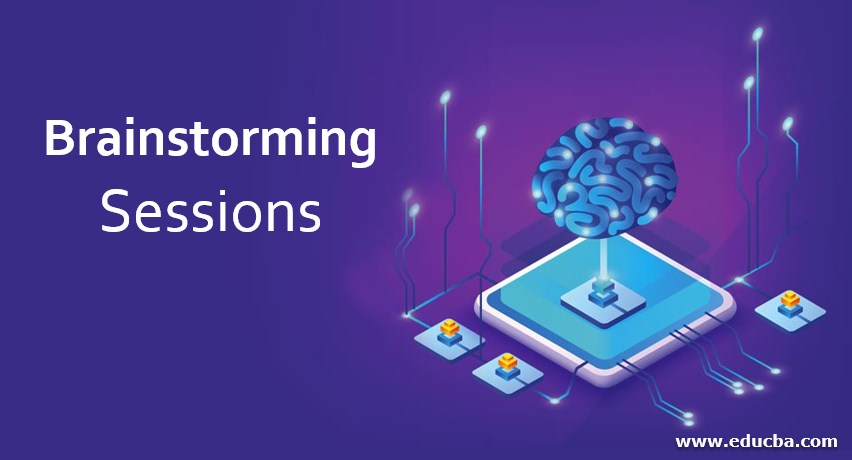Updated April 20, 2023

Introduction to Brainstorming Sessions
If you were the CEO of a company, you had two main tasks. First, you must ensure that your company makes better revenues than last quarter/year/decade. And secondly, you have to make sure that in the process of making more revenue, you are cutting the costs of production or operation.
No matter what industry you’re from, this article will immensely help you. Why? Because we will talk about brainstorming here! Brainstorm seems like a boring word, but once we get into it, we will realize that a good brainstorming session with your colleagues makes a huge difference in how you approach real-world problems in business.
And here’s the catch. After reading this article, you will conduct effective brainstorming sessions and do them as if you are the company’s CEO (even if you’re not)!
Sounds good?
Myths Busted on Brainstorming Sessions
First, we need to talk about a few myths about brainstorming. Many people dislike brainstorming as they perceive it as a mindless and time-wasting activity. But is it so? We will see the myths below and bust them one by one.
Brainstorming Sessions are Boring
Is it so? There are multiple reasons for which you may say so. You may have participated in one or two brainstorming sessions where the conductor may not have known how to make the sessions interesting, or else you belonged to the group which didn’t participate as much as they should. But brainstorming can be as fun as you can think your favorite vacation would be. Imagine sitting in a room, and you’re asked to solve a problem, and you do it. Using your idea, your company tripled its profits and halved its cost of operation. Doesn’t it sound fascinating? Would you still say that brainstorming is boring?
Brainstorming Sessions are a Waste of Time
Really? Businesses are all about ideas. And if ideas are a waste of time, then maybe you’re not in it or have not thought it over enough. Brainstorm sessions generate new ideas to solve a tricky or not-so-tricky problem. Ideas can’t be a waste of time. Yes, it may lead to an extra-time where you must focus on something very complex and exhausting. But it can never be a waste of time and effort if properly conducted.
Brainstorming Sessions Don’t Generate Useful Solutions
As a team, an organization has more room to solve a problem than an individual’s contribution. Yes, sometimes brainstorming sessions don’t generate the solution the organization is looking for, but not always. There are times when people gather up to solve a problem, and they do it in such a way that not only does the problem gets solved, but a series of systems get properly installed into the organization for future benefits. Organizations like Google always use brainstorming sessions to solve problems.
Brainstorming is Old School
Yes, you may say that. But we will teach you a technique at the end of this article that will convince you how to brainstorm version 2.0 is still in the picture and can solve a lot of problems in the organization.
Now, let’s get to the point. How would you brainstorm like a CEO of the company?
Brainstorm Like a CEO
Image source: pixabay.com
To brainstorm like a CEO, you need a method to follow each time and every time. Before we go to the method, we will explain what we mean by brainstorming like a CEO.
Brainstorming like a CEO means thinking like a CEO instead of an organizational employee.
As an employee, you’re paid a monthly salary and do as much work as you need to do. You’re a good worker, but still, you’re an employee. You have little or no idea or willingness to determine how your organization is being run.
Here enters the CEO. She knows exactly what to do in a given situation (which may not always be). But she is willing to solve a problem as fast as possible. She is willing. She is motivated. She is in charge of not how she will earn more compensation for herself but how she will generate more ideas to solve the problems.
Yes, you always don’t have the authority and power in an organization to implement an idea. But you can share them. Be willing to work on the idea in your spare time. And also, you can help your CEO and top management find loopholes they cannot find.
As a result, when you would be in a brainstorming session, you won’t feel like it’s a waste of time or boring. You will participate and help other colleagues do the same.
Here’s a Precise Method for Brainstorming Sessions
Take Charge
Most brainstorming sessions get wasted because the people involved in them are not participating in the sessions. Why? They’re not willing. If you’re the one sitting in front of the conductor of the brainstorming session, ask about how she thinks the whole brainstorming session will go. Even if she has little or no plan, you can help her with your input. But make sure you don’t do this in front of others. Rather ask her separately. The best time is just before the brainstorming session begins. If you’re the conductor, don’t think you’re here to conduct the session. You’re not only conducting the session, but you’re also equally responsible for giving the session direction. If the brainstorming session is getting unexciting, it’s your fault. So, prepare for the session. Etch out a plan about how you would conduct the session.
Image source: pixabay.com
Don’t Invite Everyone
Inviting everyone to the brainstorming sessions will be hectic for you to manage. Find out people who are top performers in that area and invite them to the brainstorming sessions. Do it in public. You can follow this way – the best performers of every month will get a chance to sit with you for brainstorming sessions. If you follow this way, there will be transparency in your leadership. But what would you do if you were not someone from top management? Simply ask the top management executive about the problem and even if you’re not a top performer, think about it and submit your answer to that person privately. As a top executive, the best ideas will not come across if you invite too many people. Ultimately, we will discuss a particular technique to help you bridge the gap.
Conduct it Within a Framework
The best brainstorming sessions follow a system. For example, the session conductor will say – “We have 1 problem to solve. And we need 3 best ideas. Our framework is ‘how to increase sales in this quarter?’ Please don’t diverge from the discussion.” If the conductor communicates the framework, it would be easier for the participants to follow it. An even somewhat-structured framework is better than no framework.
What if you’re someone who is sitting with your colleagues? How would you conduct within the framework and help your colleagues do the same? You can simply ask the conductor about the framework if she hasn’t mentioned it initially. Or else, if the conductor did explain the framework when the discussion is going in another direction, you can politely remind your colleagues about the same. This way, the brainstorming session will get solid and generate the results you and your team want to generate.
Don’t Make any Subjective Decisions
Ideas are subjective. But you need to choose ideas from the brainstorming sessions so that it has some objective or logic behind them. You cannot say an idea is useful if you don’t have data supporting it. If you’re conducting the brainstorming sessions, make sure the ideas you choose as the best should have some objectivity. And you also need to explain the why, what, which, how, and where of those ideas. For example, the 3 best ideas are selected from the brainstorming sessions.
First, you need to tell the participants why they’re best (you can also use voting if you don’t want to authorize the decision) and how the organization would implement them. You can also allocate the ideas for implementation to people who are most capable in those areas (don’t select the people out of the blue or because you like them; choose them from their performance records in the past). But if you’re not a conductor, you just need to question the conductor about the same if you’re not clear about the best ideas and why they are best. You can even find one or two limitations (if any) to those ideas, so the best ideas become full-proof.
End the Session with an Action Strategy
Brainstorming sessions fail when the time and effort invested in solving the problem don’t create action steps. Yes, results are important. But how would you achieve them? Simply by following the steps that are necessary to take. So if you’re the conductor of the brainstorming sessions, ensure you end the session with a strategy for action. Ideas are great, but they have no value if they’re not implemented properly. So make a plan for your best ideas to get executed. If you decide on one idea, that would be okay too. Don’t leave behind confusion about what to do with the best ideas from the brainstorming sessions.
If you follow the advice above, you can brainstorm like a CEO. But this is not the end of the discussion. We also have some input about how you can improve your brainstorming sessions simply by using a technique. How to use that technique? Here’s how.
Brainwriting (Brainstorming Version 2.0)
Image source: pixabay.com
Often it happens in brainstorming sessions that when one idea is presented, people listening to it get to think about it. If this happens, the people who could give original ideas get bound to only one idea given by the first person.
Leigh Thompson and Loran Nordgren, professors at Kellogg School, recommend this technique to get the maximum value out of brainstorming sessions.
The main challenge of brainstorming sessions is that the first idea/s presented gets more prominence than any other idea, even when the ideas presented later have more merit and value.
Thus by following both professors’ advice, we recommend you split the session into two halves.
In the first half, you will ask the participants to write their own ideas without getting involved in a meeting. You will present the problem. And each participant has to develop 10-15 ideas to solve the problems individually.
Once the ideas are written individually, you can call them for discussion and understand which ideas have more merit than the rest.
This technique helps create better brainstorming sessions as the main proponent who is created is not being sacrificed.
Follow this technique, and you will see a remarkable difference from what you see in normal brainstorming sessions.
Brainstorming is a valuable tool for generating and selecting ideas, customizable for your organization. It can improve problem-solving, even in virtual teams. Embrace new ideas, tweak, change, and shift for success.
Remember, brainstorming is not a tool to use authority. Be open, be supportive, and be the fresh air of the room. You will see how talented your people are if you give them room to think better.
Recommended Article
This has been a guide to Brainstorming Sessions. We have discussed the Myths, Precise Methods and Time Tested Brainstorming Sessions. You can also go through our other suggested articles to learn more –




